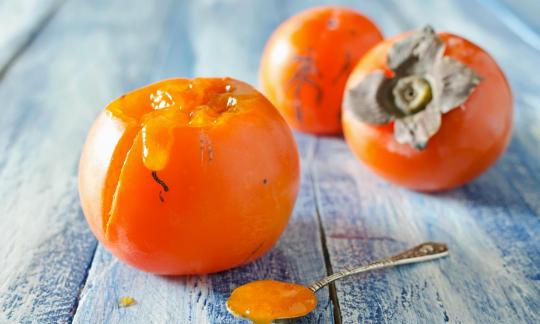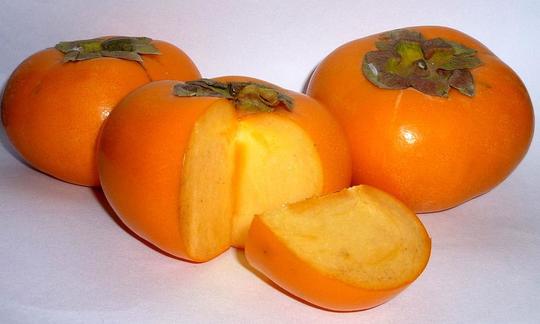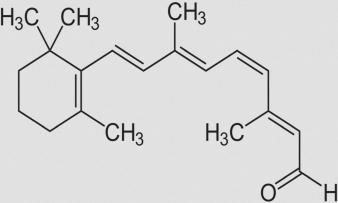Table of contents
The persimmon ( Diospyros kaki ), also called kaki plum, is used primarily for fruity desserts. It can be eaten raw , preferably in organic quality, but can also be eaten pure.
Use in the kitchen
Persimmons are round, orange to reddish fruits that look like tomatoes . When they are firm and unripe, they contain a lot of tannins, which give them a bitter taste and a furry, rough and astringent sensation. During the ripening process, the concentration of tannins decreases, which is why the fruits are generally eaten when they are ripe or overripe. 1 When is a persimmon ripe? The flesh is then very soft, almost jelly-like, and has a sweet, apricot to pear-like aroma. Should you eat hard or soft persimmons? Persimmons and Sharon are cultivated forms of persimmons that have fewer tannins due to cultivation and treatment with gas (ethylene, carbon dioxide) and are therefore edible when they are solid. Is persimmon peel edible? You can eat the peel, but it is usually removed because it is a little harder in persimmons. How do you eat soft persimmons? Typically, the ripe persimmon is cut in half and scooped out like a kiwi . Sharon fruits and persimmons with their thin skins are eaten raw whole like an apple .
The fruit can be added to breakfast muesli or porridge. It also goes well in all kinds of dessert creations, such as fruit salad, tarts, cakes, flans, muffins, raw ice cream or chocolate pudding. Soft persimmons can also be combined with other fruits, particularly acidic fruits such asraspberries and oranges, and mashed into a fine puree. Smoothies, creams, compotes, jams and marmalades can be made from the mixed or pure persimmon puree. Mixed with vegan yoghurt, you get a delicious lassi. Persimmons can also be juiced - this gives you a fine persimmon juice.
Persimmons are also used in hearty, salty dishes. They taste excellent in autumn and winter salads (e.g. with chicory , lamb's lettuce , pears , pomegranate seeds and pecans ), fruity soups, sauces and chutneys, or as a side dish to vegan dishes with white or red cabbage . Oven-baked persimmon slices sprinkled with thyme and drizzled with oil are also recommended. Spices and herbs such as chili , turmeric , cinnamon , cloves , ginger and coriander go excellently with the fruit.
If you want, you can also cut hard persimmons (Sharons) into slices and dry them in the oven or dehydrator - a snack for on the go.
Vegan recipe for persimmon chocolate pudding
Ingredients (for 2 people): 2 persimmons (ripe to overripe, raw, organic), 2 tbsp cocoa powder (unsweetened) , ½ tspvanilla powder , ¼ tsp cinnamon powder.
Preparation: Rinse the persimmons, peel them and cut them into pieces. Put the persimmon pieces in a container with the cocoa powder, vanilla and cinnamon and puree them finely using a mixer or hand blender. If you want, you can use the mixture as a winter chocolate cream or fill it into molds (e.g. Bundt cake silicone molds) and refrigerate for about 1 hour. Turn the persimmon chocolate pudding (vegan) out of the mold and decorate as desired, e.g. sprinkle with cocoa powder and serve with persimmon, apple or orange slices or pomegranate seeds.
Vegan recipes with persimmon (raw) can be found under the note: " Recipes that have the most of this ingredient ".
| Not only vegans or vegetarians should read this: Vegans often eat unhealthily. Avoidable nutritional mistakes . |
Shopping - Storage
Well-stocked branches of large supermarkets such as Coop , Migros , Rewe , Edeka and Billa offer kakis during their peak season in Europe in late autumn and early winter. 2 The cultivated varieties Persimon or Sharon are also available in stores. Other supermarkets (e.g. Denner , Volg , Spar , Aldi , Lidl , Hofer ) occasionally have kaki plums on special offer. In organic supermarkets (e.g. Alnatura , Denn's Biomarkt ) you can find kakis, persimon kakis or sharon fruits in organic quality (organic).
The pressure-sensitive consistency of persimmons makes transporting the fruit difficult. When buying, look for undamaged fruits without many brown spots, if possible.
The availability of persimmons (raw) varies depending on the size of the store, catchment area, etc. You can find our recorded food prices for the DA-CH countries above under the ingredient image - and by clicking you can see their development at various suppliers.
Storage tips
An unripe persimmon should be stored at room temperature until it has ripened. Persimmons are climacteric, ie the ripening gas ethylene regulates their ripening process. 1 Therefore, unripe specimens can be placed next to fruits that emit ethylene (eg apples ) and thus made edible more quickly.
Ripe fruit should be consumed promptly. Stored in the fridge, it will last for about 3 days. Persimmons can also be frozen. To do this, puree the pulp and mix it with a little lemon juice - this will preserve the color of the puree. If packed in airtight containers, the puree can be stored in the freezer for about a year.
Ingredients - Nutritional values - Calories
Persimmon (raw) contains 70 kcal per 100 g, which mainly come from carbohydrates. Of these 19 g carbohydrates per 100 g persimmon, 13 g are sugar, which covers 13.9% of the daily requirement. Fat (0.19 g/100g) and protein (0.58 g/100g) content are low. 4
100 g of persimmons (raw) contain 0.36 mg of manganese (18% of the daily requirement). This content is comparable to that ofblueberries (0.34 mg/100g) and strawberries (0.39 mg/100g). Pine nuts are particularly rich in manganese, with 8.8 mg/100g. 4
Raw persimmons contain 81 µg of vitamin A per 100g (10% of the daily requirement). Loquats (76 µg/100g) and apricots (96 µg/100g) contain a similar amount. Carrots contain more than ten times as much vitamin A at 835 µg/100g. 4
Raw persimmons contain 7.5 mg of vitamin C (ascorbic acid) per 100 g (9% of the daily requirement). Cherries (7.0 mg/100g), watermelons (8.1 mg/100g) and bananas (8.7 mg/100g) have comparable amounts. Sea buckthorn berries contain a lot of vitamin C at 450 mg/100g. 4
Persimmons are rich in secondary plant substances, including tannins, phenols such as flavonoids (quercetin, catechin, gallocatechin), phenolic acids (ferulic acid, p-coumaric acid, gallic acid, caffeic acid) and proanthocyanidins (condensed tannins), but also terpenoids such as steroids and carotenoids (β-cryptoxanthin, zeaxanthin, lutein, β-carotene). 1,2,3
The complete ingredients of persimmon (raw), the coverage of the daily requirement and comparison values with other ingredients can be found in our nutrient tables. In the article Nutrients explained you will get a detailed insight into the topic.
Health effects
The persimmon ( Diospyros kaki ) is rich in bioactive compounds, including phenols and carotenoids. These compounds have strong antioxidant effects and are therefore of interest for the prevention and treatment of diseases such as cardiovascular disease, diabetes, hypercholesterolemia and cancer. 1,2,5 The concentration of antioxidants depends on the variety, ripeness and parts of the fruit. Phenolic compounds and carotenoids are more abundant in the peel than in the pulp. 1,2
Catechins (flavan-3-ol) are the main flavonoids in persimmons that may offer potential benefits to human health. They exhibit antimutagenic and anticarcinogenic properties and are associated with a protective role against diseases caused by oxidative stress. 2
Proanthocyanidins are condensed tannins that have strong antioxidant activity and can help with hyperlipidemia (elevated lipid levels) and hyperglycemia (elevated blood sugar levels). Several studies have shown that the procyanidins (a subgroup of proanthocyanidins) contained in persimmons are associated with various biological functions, such as anti-inflammatory, antimicrobial, antidiabetic and antiatherogenic effects. Proanthocyanidins are also found mainly in the peel and to a lesser extent in the pulp. 1, 2
The pulp consists mainly of mucilage and pectin, which is responsible for its gelatinous consistency. These polysaccharides have a calming and anti-inflammatory effect on the digestive tract, increase stool volume by swelling with water and thus facilitate excretion. They also help to relieve intestinal complaints such as diarrhea, inflammation of the colon (colitis), intestinal cramps, flatulence and irritable bowel syndrome. 2.5
Both persimmon fruits and leaves promote coronary health as they have hypocholesterolemic, antiatherosclerotic and antioxidant properties. 3
Other health benefits attributed to persimmons include diuretic and antihypertensive properties. In addition, the bioactive components reduce arterial stiffness and prevent the oxidation of low-density lipoproteins (LDL), which leads to the prevention of the formation of atherosclerotic plaques. They also prevent dyslipidemia (lipid metabolism disorder) and metabolic syndrome. Many phytochemicals also have an antimutagenic effect and regulate and activate the immune system, which leads to the normal functioning of the metabolism. Some of them also serve as chemopreventive, anti-cancer and immunomodulatory agents. 1,2
Dangers - Intolerances - Side effects
The skin of unripe persimmons ( Diospyros kaki ) contains high concentrations of tannins. It is believed that these can polymerize when reacting with stomach acid and form a conglomerate in which cellulose, hemicelluloses and various proteins accumulate. In the case of persimmons, this tightly packed collection of indigestible material, which is stuck in the gastrointestinal tract (usually in the stomach), is called a diospyrobezoar (a type of phytobezoar; bezoar made from plant materials such as fibers, peels and seeds of vegetables and fruits). It is caused by frequent consumption of tannin-rich persimmons. The formation of bezoars is, however, a relatively rare condition. Compared to other phytobezoars, persimmon phytobezoars are more difficult to dissolve chemically or break into small pieces due to their hard consistency. They usually have to be removed endoscopically or surgically. 6
Folk medicine - natural medicine
In traditional Chinese medicine ( TCM ), persimmons are used in the treatment of high blood pressure, bleeding, diabetes and arteriosclerosis, among other things. The fruit is also used to improve the function of the lungs, spleen, stomach and intestines, to maintain body temperature and slow down oxidative processes, as well as to prevent and treat sore throats, thrush and insomnia. 2
Ecological footprint - animal welfare
The CO 2 footprint of a food depends on various aspects, such as cultivation method (conventional/organic), seasonality, country of origin, processing, transport and, if applicable, packaging. According to CarbonCloud, the production of 1 kg of persimmons causes 0.58 kg CO 2 eq. 7
The main season for European persimmons is between October and December, during which they mainly come from Italy or Spain. Ideally, you should pay attention to the origin when shopping and avoid buying persimmons outside of these months. Availability in supermarkets throughout the rest of the year is ensured by imported products from other continents, some of which come to Europe by air. This has a negative impact on their ecological footprint due to increased emissions.
A measurement of the water footprint of persimmons grown in Korea shows that the amount of water required is similar to that required to produce apples and peaches (between 1000 and 1500 liters of water per 1 kg of fruit). 8
In order to keep the use of synthetic pesticides and mineral fertilizers, which have been proven to have a negative impact on the environment and health, as low as possible due to conventional agriculture, it is better to use organic persimmons from organic farming.
Worldwide occurrence - cultivation
Persimmon ( Diospyros kaki ) probably originated in East Asia. 1,9 The cultivation of persimmons in China can be dated back 2000 years. 10
Persimmon trees are widespread in temperate to subtropical regions. Regions with relatively mild summers and moderate winters are particularly suitable for persimmon tree growth. Many varieties are well adapted to warm, humid climates. However, they are also grown in dry locations with irrigation. The leading and high-yielding varieties are, however, adapted to a temperate climate. 1,9 The trees, which grow up to 8 m tall, produce 80-100 kg of fruit annually in the best case. 11
Recently, the popularity of persimmons has expanded beyond its traditional growing areas (China, Japan, South Korea). It has become a promising crop in Brazil and some Mediterranean countries. 2
The largest producer of persimmons in 2022 was China, followed by Korea, Japan, Azerbaijan and Brazil. In Europe, persimmons are also grown in Spain and Italy. 12
Found in the wild
Wild trees of the species Diospyros kaki have been found in Chinese forests. 13
Growing in the garden
If you would like to plant a persimmon tree in your garden in Central Europe, you should choose a frost-tolerant variety. Before planting it outside, you should cultivate it in a pot for the first three to four years, which you can then move indoors to a dark and cool (approx. 5 °C) location in winter. After that, you can plant it outdoors - preferably in spring, when there is no longer any frost. Warm, sunny and wind-protected locations are ideal for the persimmon tree. A house wall on the south side is a good option. It also prefers loose, sandy-loamy soil with a high nutrient content and a neutral pH value. The nutrient content of the soil can be enriched with compost or an organic fertilizer. Once the tree has been planted (only placed as deep in the hole as it was in the pot), you should water it well. 14
The plant must be watered regularly while it is still in the pot, but waterlogging should be avoided. During the winter, it should only be watered once a month. In the open field, it should only be watered during dry periods, as this will otherwise affect fruit development. Fertilizer should not be used too much either - not at all in the first month after planting, and from May to the end of July with a potassium-rich fertilizer that supports fruit formation. The planted tree should be protected from frost in winter with a thick layer of mulch in the root area. 14
Persimmons are ready to harvest from October onwards. The fruits should be left to ripen on the now leafless tree for as long as possible (until the first frost). If the fruits are not yet ripe, they can be left to ripen. If they are placed next to fruit that emits ripening gas (ethylene), such as apples or pears , they will be ripe and soft within two weeks. 14
Further information
Kaki is the fruit of the persimmon tree ( Diospyros kaki ) and belongs to the ebony family (Ebenaceae). The genus name Diospyros comes from the Greek dióspuron, which means "food of Zeus" or "fruit of the gods", while the species name comes from the Japanese word kaki (柿). 2
The genus Diospyros includes four commercially important species. The most representative species is Diospyros kaki . There are also Diospyros virginiana (American persimmon), Diospyros oleifera and Diospyros lotus (lotus plum). 2
Persimmons ( Diospyros kaki) are divided into non-astringent and astringent varieties depending on their taste. In the early stages of development, persimmon fruits accumulate large amounts of tannins in specialized tannin cells, which are responsible for the astringency. The astringency decreases with ripening, but also through artificial treatments such as drying and treatment with carbon dioxide gas or ethanol vapor. This is due to the decrease in tannin content, more precisely the conversion of water-soluble tannins into insoluble forms. Astringent varieties, however, still contain soluble tannins after full ripeness, which cause an astringent mouthfeel, while non-astringent varieties lose their astringency by the time they are ripe. 1,9
'Mopan' is one of the most important astringent persimmons grown in northern China. 'Fuyu' is the most important non-astringent variety grown in Japan, which should be eaten before it is fully ripe, otherwise it is too soft. 1 The Spanish variety 'Rojo Brillante' is a high-yielding astringent variety, but is sold only after being treated with carbon dioxide gas to remove the astringency. 9 Such treatments with gases such as carbon dioxide or ethylene are common practices for certain astringent varieties, but can lead to undesirable color changes in the fruit. 1
What is the difference between kaki, persimmon and sharon? Both persimmon and sharon are cultivated forms/varieties of kaki. The Spanish kaki variety 'Rojo Brillante' is marketed in Europe as a persimmon. It is relatively large and has an elongated (not round) shape when cut lengthwise. The seedless sharon fruit or sharon is a kaki variety (usually 'Triumph') from Israel that is slightly smaller and flatter than a normal kaki and also has a lighter, thinner skin. Both cultivated forms are largely artificially freed of the astringent tannins through gas treatment and can be eaten in the solid state. 15,16
Alternative names
Alternative names for kaki are kaki plum, Chinese quince, date plum, Japanese kaki and fruit of the gods. Other names for the fruit are honey apple, persimmon and sharon fruit, although these are varieties of kaki.
In English, persimmons are called kaki persimmon, oriental persimmon, Chinese persimmon, Japanese persimmon or simply persimmon.
Other uses
The uses of the persimmon go beyond the kitchen table. There is talk of using persimmon waste to produce biofuel, more environmentally friendly reducing agents for textile dyes, greener plant growth regulators and biodegradable films for vegetable packaging. 2 One study also looked at the potential of the persimmon calyx (four greenish sepals that are not eaten) for producing antioxidants. 17










Comments